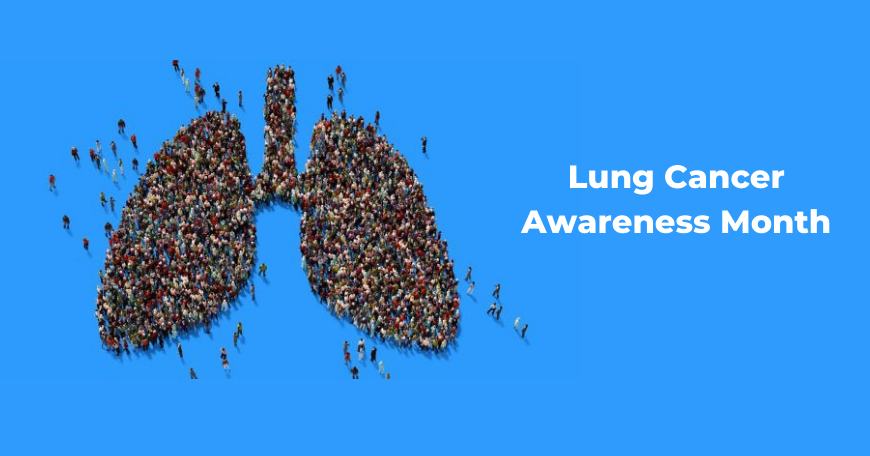Lung Cancer Awareness Month 2019
555 viewsLung Cancer Awareness Month 2019
The World Health Organization states that cancer is a leading cause of death worldwide accounting for an estimated 9.6 million deaths in 2018. There were 2.09 million cases of lung cancer. In 2018, lung cancer alone was responsible for 1.76 million deaths.
Lung Cancer is a leading cause of cancer death in men and women the world over. Therefore it is only fitting to dedicate an entire month to spread its awareness. According to the Lung Cancer Awareness Month Coalition, Lung Cancer Awareness Month is a month-long activity wherein organizations all over the world conduct advocacy and outreach activities in various ways to spread awareness about the dangers of lung cancer, its causes, prevention etc. among people and medical professionals.
Cancer
Cancer is a disease characterized by uncontrolled growth of cells in the body affecting body parts and organs such as our lungs, prostate etc. Our body’s cells are the basic units of life[1] and when the body’s ability to produce the optimal number of cells fails, the excess cell growth accumulates into tumours. These tumours are benign or harmless but, those that are harmful are known as malignant tumours. Malignant tumours can also spread to other parts of the body. This condition is known as metastasis and malignant tumours can become cancerous.
Lung Cancer
Our lungs are critical organs that support life. Lungs perform the function of filtering air and supplying oxygen to the rest of the body and keep it healthy and functioning
Lung cancer has a higher tendency for metastasis. Lung cancer begins to metastasize very early after its formation and tend to spread to the bones, brain, adrenal glands and liver. This is why it is imperative to prevent lung cancer owing to its properties of spreading quickly to other vital organs of the body and making it all the more difficult to treat. This is why it is extremely important to prevent lung cancer.
There are two types of lung cancers: Small-Cell Lung Cancers (SCLC) and Non-Small-Cell Lung Cancers (NSCLC). It is important to differentiate between the two as treatments vary for both.
- SCLCs are mainly caused due to smoking. Only 1% of these cancers affect non-smokers. SCLCs account for 20% of lung cancers. They spread quickly and the most aggressive lung cancers.
- NSCLCs make up for 80% of all lung cancers and can occur in smokers and non-smokers and people who have never smoked in their life.
Causes of Lung Cancer
The main cause of lung cancer is attributed to tobacco use or smoking. Almost 80% of total deaths caused due to lung cancer are a result of smoking. However there are other causes that give rise to lung cancer. This implies that non-smokers are also susceptible to developing lung cancer. Passive smoking is also a cause of lung cancer. It is therefore important to bust the myth that only smokers are prone to getting lung cancer.
The following is a list of causes of Lung Cancer:[2]
- Smoking
- Passive Smoking
- Exposure to asbestos and radon gas (for smokers chances of getting lung cancer are high)
- Genetic factors such as a family history of lung cancer
- Presence of diseases such as Chronic Obstructive Pulmonary Disease (COPD) and Pulmonary Fibrosis heighten chances of lung cancer in a person
- Lung Cancer Survivors or a prior history of lung cancer increases the chances of cancer recurring
- Air Pollution
- Exposure to diesel exhaust fumes. Occupations such as those of truck drivers, miners etc. run a high risk of getting lung cancer
Symptoms
In most cases, lung cancer symptoms stay hidden until the cancer has spread. Once the cancer has spread, these are the following symptoms that develop:
The American Cancer Society outlines the following most common symptoms of lung cancer[3]:
- A cough that does not go away or gets worse
- Coughing up blood or rust-colored sputum (spit or phlegm)
- Chest pain that is often worse with deep breathing, coughing, or laughing
- Hoarseness
- Loss of appetite
- Unexplained weight loss
- Shortness of breath
- Feeling tired or weak
- Infections such as bronchitis and pneumonia that won’t go away or keep coming back
- New onset of wheezing
If lung cancer spreads to other parts of the body, it may cause:
- Bone pain (like pain in the back or hips)
- Nervous system changes (such as headache, weakness or numbness of an arm or leg, dizziness, balance problems, or seizures), from cancer spread to the brain
- Yellowing of the skin and eyes (jaundice), from cancer spread to the liver
- Swelling of lymph nodes (collection of immune system cells) such as those in the neck or above the collarbone
–American Cancer Society, 2019.
Prevention Measures
- Early screening and detection after symptoms can increase chances of lung cancer prevention
- The complete cessation of smoking drastically brings down the chances of developing lung cancer. Seeking appropriate counseling and therapy for the same makes it easier to quit tobacco and not resume it.
- Implementation of Tobacco Control by state and national governments including stricter market policies and taxation on tobacco as a commodity.
- A healthy diet of fruits and vegetables is highly recommended but cannot be effective if a person continues to smoke. A healthy diet can be added on as a preventive measure but in addition to quitting smoking altogether.
[1] Lung Cancer, Medicine Net, https://www.medicinenet.com/lung_cancer/article.htm
[2] Lung Cancer, 2019. https://www.medicinenet.com/lung_cancer/article.htm
[3] American Cancer Society, Signs and Symptoms of Lung Cancer, https://www.cancer.org/cancer/lung-cancer/causes-risks-prevention/what-causes.html

